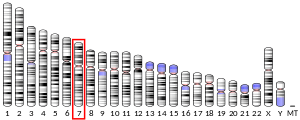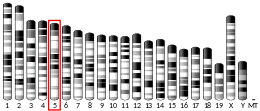LMBR1
Limb region 1 protein homolog is a protein that in humans is encoded by the LMBR1 gene.[5][6][7]
| LMBR1 | |||||||||||||||||||||||||
|---|---|---|---|---|---|---|---|---|---|---|---|---|---|---|---|---|---|---|---|---|---|---|---|---|---|
| Identifiers | |||||||||||||||||||||||||
| Aliases | LMBR1, ACHP, C7orf2, DIF14, PPD2, TPT, ZRS, LSS, THYP, limb development membrane protein 1 | ||||||||||||||||||||||||
| External IDs | OMIM: 605522 MGI: 1861746 HomoloGene: 49706 GeneCards: LMBR1 | ||||||||||||||||||||||||
| |||||||||||||||||||||||||
| |||||||||||||||||||||||||
| Orthologs | |||||||||||||||||||||||||
| Species | Human | Mouse | |||||||||||||||||||||||
| Entrez | |||||||||||||||||||||||||
| Ensembl | |||||||||||||||||||||||||
| UniProt | |||||||||||||||||||||||||
| RefSeq (mRNA) |
| ||||||||||||||||||||||||
| RefSeq (protein) |
| ||||||||||||||||||||||||
| Location (UCSC) | Chr 7: 156.67 – 156.89 Mb | Chr 5: 29.23 – 29.38 Mb | |||||||||||||||||||||||
| PubMed search | [3] | [4] | |||||||||||||||||||||||
| Wikidata | |||||||||||||||||||||||||
| |||||||||||||||||||||||||
This gene encodes a member of the LMBR1-like membrane protein family. Another member of this protein family has been shown to be a lipocalin transmembrane receptor. A highly conserved, cis-acting regulatory module for the sonic hedgehog (protein) gene is located within an intron of this gene. Consequently, disruption of this genic region can alter sonic hedgehog expression and affect limb patterning, but it is not known if this gene functions directly in limb development. Mutations and chromosomal deletions and rearrangements in this genic region are associated with acheiropody and preaxial polydactyly, which likely result from altered sonic hedgehog expression.[7]
References
- GRCh38: Ensembl release 89: ENSG00000105983 - Ensembl, May 2017
- GRCm38: Ensembl release 89: ENSMUSG00000010721 - Ensembl, May 2017
- "Human PubMed Reference:". National Center for Biotechnology Information, U.S. National Library of Medicine.
- "Mouse PubMed Reference:". National Center for Biotechnology Information, U.S. National Library of Medicine.
- Heus HC, Hing A, van Baren MJ, Joosse M, Breedveld GJ, Wang JC, Burgess A, Donnis-Keller H, Berglund C, Zguricas J, Scherer SW, Rommens JM, Oostra BA, Heutink P (Aug 1999). "A physical and transcriptional map of the preaxial polydactyly locus on chromosome 7q36". Genomics. 57 (3): 342–51. doi:10.1006/geno.1999.5796. PMID 10329000.
- Ianakiev P, van Baren MJ, Daly MJ, Toledo SP, Cavalcanti MG, Neto JC, Silveira EL, Freire-Maia A, Heutink P, Kilpatrick MW, Tsipouras P (Jan 2001). "Acheiropodia is caused by a genomic deletion in C7orf2, the human orthologue of the Lmbr1 gene". Am J Hum Genet. 68 (1): 38–45. doi:10.1086/316955. PMC 1234933. PMID 11090342.
- "Entrez Gene: LMBR1 limb region 1 homolog (mouse)".
Further reading
- Hing AV, Helms C, Slaugh R, et al. (1996). "Linkage of preaxial polydactyly type 2 to 7q36". Am. J. Med. Genet. 58 (2): 128–35. doi:10.1002/ajmg.1320580208. PMID 8533803.
- Sanger Centre, The; Washington University Genome Sequencing Cente, The (1999). "Toward a complete human genome sequence". Genome Res. 8 (11): 1097–108. doi:10.1101/gr.8.11.1097. PMID 9847074.
- Clark RM, Marker PC, Kingsley DM (2001). "A novel candidate gene for mouse and human preaxial polydactyly with altered expression in limbs of Hemimelic extra-toes mutant mice". Genomics. 67 (1): 19–27. doi:10.1006/geno.2000.6225. PMID 10945466.
- Hartley JL, Temple GF, Brasch MA (2001). "DNA cloning using in vitro site-specific recombination". Genome Res. 10 (11): 1788–95. doi:10.1101/gr.143000. PMC 310948. PMID 11076863.
- Dundar M, Gordon TM, Ozyazgan I, et al. (2001). "A novel acropectoral syndrome maps to chromosome 7q36". J. Med. Genet. 38 (5): 304–9. doi:10.1136/jmg.38.5.304. PMC 1734869. PMID 11333865.
- Clark RM, Marker PC, Roessler E, et al. (2002). "Reciprocal mouse and human limb phenotypes caused by gain- and loss-of-function mutations affecting Lmbr1". Genetics. 159 (2): 715–26. PMC 1461845. PMID 11606546.
- Lettice LA, Horikoshi T, Heaney SJ, et al. (2002). "Disruption of a long-range cis-acting regulator for Shh causes preaxial polydactyly". Proc. Natl. Acad. Sci. U.S.A. 99 (11): 7548–53. doi:10.1073/pnas.112212199. PMC 124279. PMID 12032320.
- Strausberg RL, Feingold EA, Grouse LH, et al. (2003). "Generation and initial analysis of more than 15,000 full-length human and mouse cDNA sequences". Proc. Natl. Acad. Sci. U.S.A. 99 (26): 16899–903. doi:10.1073/pnas.242603899. PMC 139241. PMID 12477932.
- Horikoshi T, Endo N, Shibata M, et al. (2003). "Disruption of the C7orf2/Lmbr1 genic region is associated with preaxial polydactyly in humans and mice". J. Bone Miner. Metab. 21 (1): 1–4. doi:10.1007/s007740300000. PMID 12491086.
- Scherer SW, Cheung J, MacDonald JR, et al. (2003). "Human chromosome 7: DNA sequence and biology". Science. 300 (5620): 767–72. doi:10.1126/science.1083423. PMC 2882961. PMID 12690205.
- Lettice LA, Heaney SJ, Purdie LA, et al. (2003). "A long-range Shh enhancer regulates expression in the developing limb and fin and is associated with preaxial polydactyly" (PDF). Hum. Mol. Genet. 12 (14): 1725–35. doi:10.1093/hmg/ddg180. PMID 12837695.
- Hillier LW, Fulton RS, Fulton LA, et al. (2003). "The DNA sequence of human chromosome 7". Nature. 424 (6945): 157–64. doi:10.1038/nature01782. PMID 12853948.
- Ota T, Suzuki Y, Nishikawa T, et al. (2004). "Complete sequencing and characterization of 21,243 full-length human cDNAs". Nat. Genet. 36 (1): 40–5. doi:10.1038/ng1285. PMID 14702039.
- Sagai T, Masuya H, Tamura M, et al. (2004). "Phylogenetic conservation of a limb-specific, cis-acting regulator of Sonic hedgehog ( Shh)". Mamm. Genome. 15 (1): 23–34. doi:10.1007/s00335-033-2317-5. PMID 14727139.
- Gerhard DS, Wagner L, Feingold EA, et al. (2004). "The status, quality, and expansion of the NIH full-length cDNA project: the Mammalian Gene Collection (MGC)". Genome Res. 14 (10B): 2121–7. doi:10.1101/gr.2596504. PMC 528928. PMID 15489334.
- Wiemann S, Arlt D, Huber W, et al. (2004). "From ORFeome to biology: a functional genomics pipeline". Genome Res. 14 (10B): 2136–44. doi:10.1101/gr.2576704. PMC 528930. PMID 15489336.
- Kimura K, Wakamatsu A, Suzuki Y, et al. (2006). "Diversification of transcriptional modulation: large-scale identification and characterization of putative alternative promoters of human genes". Genome Res. 16 (1): 55–65. doi:10.1101/gr.4039406. PMC 1356129. PMID 16344560.
- Mehrle A, Rosenfelder H, Schupp I, et al. (2006). "The LIFEdb database in 2006". Nucleic Acids Res. 34 (Database issue): D415–8. doi:10.1093/nar/gkj139. PMC 1347501. PMID 16381901.



